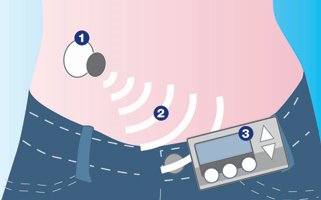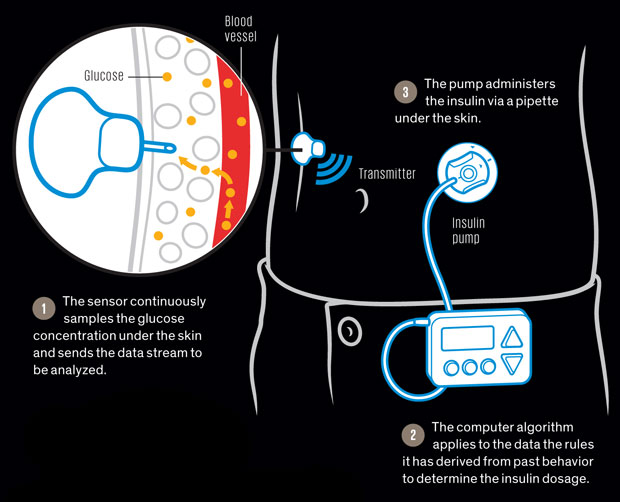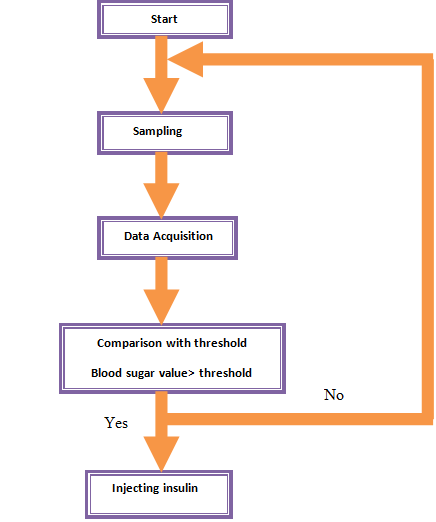Sections
Pancreas is the glandular organ located in the abdomen in between stomach and spine. Some part of the pancreas is covered with duodenum which is the first part of small intestine. It produces various hormones like insulin, glucagon etc. These hormones are circulating in the blood. The concentration of glucose in the blood is controlled by insulin. Insulin maintains the glucose level without increasing or decreasing a particular limit. The cells in the body get energy from sugar. Most of the cells can’t absorb sugar directly. The sugar concentration in blood will increase after consuming food. At that time, the pancreas will produce the insulin hormone and circulate in blood. This allows the cells to absorb sugar from blood. It is thereafter stored for future purpose. If the body contains more sugar than it requires, the insulin helps to store the sugar in liver for future use. It releases when the body requires more sugar or if there is decrease in sugar level. If the sugar content decreases than a particular limit, then the patient may faint. If the sugar content increases than a limit, then heart failure, kidney failure may occur etc.The high level of sugar in blood will destroy the blood vessels in the body, kidney, heart etc. The blood flow to the organ gets stopped and hence the function of organs. This will lead to death of the patient. So it is important to balance the sugar concentration in the blood.
The normal range of blood glucose level after fasting is between 70-100mg/dL. It is the normal range. For random blood glucose test, the level depends upon the food ate. The glucose levels in such cases are below 125mg/dL. These results may vary in different laboratories according to the test specimen.
Type 1 diabetes patient can’t make insulin. So they cannot maintain the sugar level in a normal range. It will lead to increase in the concentration of sugar in blood. It is seen in all ages. But mostly it is seen in children. So it is called as juvenile diabetes. To reduce this risk, insulin will be injected to maintain the glucose level. The most common diabetes is Type 2 diabetes. In Type 2 diabetes, enough insulin is not produced by the pancreas.
If the patient has Type 1 diabetes, then the body will not produce insulin. So the patient must inject the insulin. There are several methods to take insulin such as injection, insulin pens, inhaled insulin etc.
It is a portable device which contains insulin. It will be injected to the patient regularly. The device is very small and it can be put in pockets or belt etc. The insulin flows through the small tube which is placed under the skin.
It is a portable device which gives real time information about blood sugar level. It displays the values of sugar level in the blood. This data helps to take appropriate measures and avoids complications due to diabetes.
Islet cells are the cells in pancreas which produces insulin. The islet cells are taken from donors and put it into the patients having Type 1 diabetes. This is an effective treatment. The main problems are these cells can last for only few years. Also, there may be a chance that the body reject these cells.
2. ARTIFICIAL PANCREAS
Diabetes can’t be cured. Today, its a burden to the patient to check the blood sugar level every time and take injection. So, a computing device will do better. Hence, an automatic device is designed to monitor the sugar level and also for injecting insulin. The device is named as Artificial Pancreas.

Artificial Pancreas
In the artificial pancreas technique, the blood sugar sensor is worn on the patient body. It measures the sugar level in the blood in every minute. The data from the sensor is transmitted to the insulin pump worn on the body. It will calculate and the patient can inject insulin depending on the computing value which is displayed in the monitor in the required amount. Artificial Pancreas consists of mainly:
According to the high or low level of blood sugar, the patient can inject the insulin or it helps to diet and exercise by using this information displayed in the monitor. But artificial pancreas technique is not completely automated. Still it needs monitoring the value that is displayed in the monitor for injecting the insulin. The artificial pancreas provides regular reading of blood sugar. It displays the value of blood sugar levels. It gives information about rise and fall of blood sugar. So artificial pancreas can predict the future values. It helps to take measures according to that. If it shows high sugar level, then the patient can immediately take insulin for injection. If it shows low sugar level, then the patient can reduce the amount of injecting insulin. Artificial Pancreas technique allows patients to take food according to that or the patient can take appropriate exercise. This real time data will help to control the insulin level.
In 1970, insulin pump was invented by Dean Kamen. It was used for injecting insulin in a regular manner instead of frequent injections. It is done by the patient themselves. After that in Germany, Biostator GCIIS was released. It uses the combination of insulin pump and continuous glucose monitor. In 2014, an artificial pancreas named Medtronic’s Minimed 530G, which was the first machine sold in United States. In January, Medtronic sold 640T. This device has the ability to predict the reduction in blood sugar level. It will stop the flow of insulin.
Robo-Pancreas is an artificial pancreas which consists of sensors, actuators, algorithm, and insulin pump. Robo-Pancreas can be used to indicate blood sugar level. It detects the reduction or increase in the level of sugar in blood. It will automatically inject insulin to the blood. Robo-pancreas is designed to help diabetic patients, especially Type 1 diabetes (juvenile diabetes). It consists of sensors, actuators, algorithms.

Robo-Pancreas- Working as Artificial Pancreas
The block diagram of robo-pancreas is shown below.

Block Diagram of Robo-Pancreas- Working as Artificial Pancreas
They will automatically control the level of the sugar in blood. It will monitor the sugar level in the blood at any time and inject insulin if it requires. Not only insulin but also some other hormones are secreted by pancreas such as glucagon. While increasing the level of sugar in the blood stream, the liver stores this for future use. The glucose is converted into glycogen in the liver. The glycogen is converted into glucose by stimulating the liver using the hormone glucagon. The glucose is spread in the blood stream. Whenever the level of sugar in blood decreases, at that time the liver converts the glycogen into glucose. The pancreas releases glucagon if there is a decrease in the sugar level. Glucagon helps the liver to convert glycogen into glucose. The function of glucagon is just opposite to the function of insulin.

Robo-Pancreas- Working as Artificial Pancreas
The dual hormone pump releases insulin and glucagon. The insulin lowers the sugar level and glucagon raises the sugar level in blood stream. But researchers are now concentrating on single hormone pump. The researcher compares the single hormone method and dual hormone method and they didn’t find any further advantages in dual hormone method.
By using this device, the adverse effects of diabetes can be reduced. Due to the continuous monitoring and function like pancreas, the device can predict the change of sugar level in blood and can take measures according to it. It will be a great medical aid for the diabetic patients. It is easily affordable and accessible. It will not damage quickly. Presently, an automated device which works like pancreas is not common.
Sections